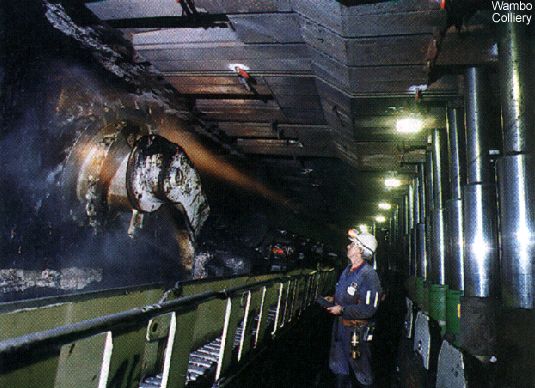HISTORY AND METHODS
Overview 0 Commentn longwall mining, large rectangular blocks of coal are defined during the development stage of the mine and are then extracted in a single continuous operation. Generally each defined block of coal, know as a panel, is created by driving a set of headings from main or trunk roadways in the mine, some distance into the panel. These roadways are then joined to form the starting face of longwall face. Coal is extracted mechanically from all the Australian longwall faces. As the coal is cut the longwall face is supported with hydraullically operated supports. The function of these supports is to provide a safe working environment by supporting the roof as coal is extracted as well as advancing the longwall equipment. As the face advances the immediate roof above the coal is allowed to collapse behind the line of supports forming the goaf.
Currently there are two types of longwall cutting machines:
- The shearer, which is the only type used in Australian mines today
- The plough, used mainly in Europe and to a lesser extent in the USA.
The coal shearer is a more complex machine in comparison to the plough which is nothing more than a blade like solid block segments fitted with picks. The plough is pulled across the face with chains powered by motors mounted at one end of the face. Details of the coal shearer and plough are covered in the equipment module.
Longwall mining is increasing in application to coal winning in Australian Underground mining operations. The mechanised method of longwall mining was first introduced to Australia in 1963 and currently (2005)there are 27 longwall faces operating in Australia. Production from Australia’s longwall faces represented 18% of Australia’s raw black coal production of 398 million tonnes in 2005. This percentage accounts to 89% of Australia’s total underground black coal production of 80 million tonnes.Click here
There are two methods of longwall mining that are used throughout the world :
There are two methods used to cut a web of coal from the longwall face
- The “Bi-Directional” (bi-di) method
- The shearer cuts a fresh web of coal each time it traverses up and down the coal face
- The “Uni-Directional” (uni-di) method
- The shearer cuts a web of coal from one side of the face to the other and then returns back down the face to clean up the original web without further advancement of the powered supports.

